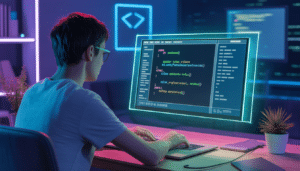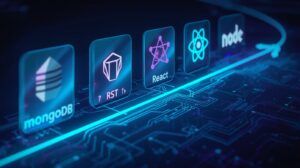Deep learning isn’t just a buzzword; it’s the engine driving today’s most significant technological breakthroughs. From facial recognition on your smartphone to the algorithms powering self-driving cars, deep learning has become a cornerstone of the modern tech industry. The rapid growth of this field means that professionals with deep learning skills are in high demand, making it a fantastic area for students and aspiring engineers to specialize in.
Theoretical knowledge alone isn’t enough to succeed in this competitive landscape. To truly stand out, you need practical experience gained through hands-on projects. This blog is your ultimate guide, designed to help you navigate the world of deep learning projects. We’ll explore the best deep learning projects for beginners who are just starting their journey and more advanced deep learning projects for final year students looking to create a standout portfolio. These real-world project ideas are more than just academic exercises; they’re stepping stones to boosting your career. Let’s dive in and find the perfect project to elevate your skills and career prospects.
What is Deep Learning?
Deep learning is a subfield of machine learning, which is a subfield of artificial intelligence (AI). While AI is the broad concept of machines that can think and act like humans, machine learning is the method of using algorithms to allow systems to learn from data without being explicitly programmed. Deep learning takes this a step further by using neural networks with multiple layers (hence, “deep”) to learn increasingly complex patterns from vast amounts of data. This multilayered structure is what distinguishes it from traditional machine learning.
The core components of a deep learning model are:
- Neural Networks: These are inspired by the human brain, consisting of interconnected nodes or “neurons” organized into layers.
- Activation Functions: These functions determine whether a neuron should be activated, introducing non-linearity to the network and allowing it to learn complex relationships.
- Layers and Architecture: Deep neural networks have an input layer, one or more hidden layers, and an output layer. The complexity and number of these layers define the network’s architecture.
- Data and Training: Deep learning models require massive datasets to train on. The training process involves feeding data to the network, and the model adjusts its internal parameters (weights and biases) to minimize errors.
Deep learning’s ability to handle unstructured data like images, audio, and text has led to its adoption across various industries, including healthcare (disease prediction), finance (fraud detection), and entertainment (recommendation systems). For students, focusing on deep learning projects is crucial because it provides practical experience with these cutting-edge techniques and a tangible way to demonstrate your skills to potential employers.
Why Deep Learning Projects are Important for Students
Working on deep learning projects for students is invaluable for several reasons. It bridges the gap between theoretical knowledge and practical application, allowing you to move beyond textbook concepts. A well-executed project is a powerful tool for building a strong portfolio that showcases your technical skills, problem-solving abilities, and creativity.
A solid portfolio of deep learning projects for final year students is a huge advantage in the job market, significantly increasing your chances of securing internships and full-time roles. Employers value candidates who can demonstrate real-world experience. Moreover, projects are a fantastic way to prepare for your final year project or research work, as they help you learn how to define a problem, gather and preprocess data, and implement a solution from scratch. Finally, the challenges you face during a project—like debugging code or optimizing a model—help you develop the critical problem-solving skills needed for technical interviews.
How to Choose the Best Deep Learning Projects
Choosing the best deep learning projects is an essential step toward building your skills, strengthening your portfolio, and achieving your academic or career goals. Instead of simply selecting a project because it is trending, it’s important to evaluate whether it aligns with your skill level and long-term aspirations. The right choice of project can help you gain practical experience and showcase your expertise in real-world applications.
1. Match Your Skill Level
When exploring the best deep learning projects, your current skill level should be the primary deciding factor. Picking a project that matches your abilities will help you learn effectively while avoiding unnecessary frustration.
- Beginners should start with simple, foundational projects like image classification or sentiment analysis. These basic projects build core knowledge and introduce you to essential concepts in deep learning.
- Intermediate learners can explore slightly more challenging projects such as face recognition or text summarization. These best deep learning projects enhance your understanding of neural networks and practical applications.
- Final year students or advanced learners can take on complex, real-world projects like real-time object detection, autonomous systems, or medical image segmentation.
- The goal is to choose one of the best deep learning projects that challenges you to grow while remaining achievable within your timeframe and resources.
2. Tools and Technologies for the Best Deep Learning Projects
To successfully complete the best deep learning projects, you must be equipped with the right tools, frameworks, and programming languages. Having access to efficient resources ensures smoother development and faster progress.
- Python is the most widely used language for deep learning due to its simplicity and extensive libraries.
- Popular libraries such as TensorFlow, Keras, PyTorch, and OpenCV are essential for designing, building, and training deep learning models.
- These tools make it easier to implement algorithms, fine-tune models, and experiment with various datasets while working on the best deep learning projects.
Whether you are working on an academic project or a professional solution, mastering these technologies is key to achieving high-quality results.
3. Common Mistakes to Avoid in the Best Deep Learning Projects
While working on the best deep learning projects, it’s common to encounter challenges. Avoiding these mistakes will help you complete your project more efficiently and effectively.
- Don’t start too big: Begin with a small, functional model before scaling it up. Many students choose complex best deep learning projects without understanding the basics, which often leads to burnout.
- Avoid poor documentation: Write clean, readable, and well-structured code. Proper documentation ensures your project can be understood and maintained by others in the future.
- Plan for scalability: Think ahead about how your project can grow. The best deep learning projects are designed with scalability in mind, allowing for improvements and additional features over time.

Best Deep Learning Projects for Beginners
These are the best deep learning projects for beginners to get you started. They are designed to teach foundational concepts without overwhelming you.
- Handwritten Digit Recognition using MNIST
- Description: This classic “Hello, World!” of deep learning involves building a neural network to classify handwritten digits (0-9). The MNIST dataset is a go-to for its simplicity.
- Tools: Python, TensorFlow/Keras.
- Key Learning Outcomes: Understanding neural network architecture, data preprocessing, and model training.
- Image Classification with CIFAR-10
- Description: A step up from MNIST, this project involves classifying images into 10 categories like ‘airplane’ and ‘dog.’ It introduces you to working with color images and Convolutional Neural Networks (CNNs).
- Tools: Python, TensorFlow/Keras.
- Key Learning Outcomes: Fundamentals of CNNs, image data augmentation, and multiclass classification.
- Chatbot for Basic Conversations
- Description: Create a simple chatbot that can respond to basic user queries. This is an excellent introduction to Natural Language Processing (NLP) and sequence models.
- Tools: Python, NLTK, TensorFlow/Keras.
- Key Learning Outcomes: Text preprocessing, building sequence-to-sequence models, and understanding intent recognition.
- Sentiment Analysis on Social Media Data
- Description: Analyze text data from platforms like Twitter to determine if the sentiment is positive, negative, or neutral. This project has direct applications in marketing and brand monitoring.
- Tools: Python, NLTK, scikit-learn, TensorFlow/Keras.
- Key Learning Outcomes: Text vectorization, recurrent neural networks (RNNs), and text classification.
- Object Detection for Smart Cameras
- Description: Build a model to detect and identify objects in images. A good starting point is to use pre-trained models like YOLO (You Only Look Once) with an established dataset.
- Tools: Python, OpenCV, TensorFlow.
- Key Learning Outcomes: Introduction to computer vision, object detection algorithms, and using pre-trained models.
- Fake News Detection System
- Description: Develop a deep learning model to classify articles as either “real” or “fake” based on their text content. This is a timely project with significant social impact.
- Tools: Python, scikit-learn, TensorFlow.
- Key Learning Outcomes: Text feature extraction, NLP for classification, and model evaluation metrics like precision and recall.
- Movie Recommendation System
- Description: Build a system we suggests movies to a user based on their viewing history and preferences. This project introduces the concept of collaborative filtering and neural networks for recommendations.
- Tools: Python, TensorFlow, Pandas.
- Key Learning Outcomes: Understanding recommendation algorithms and working with large datasets.
- Language Translation Model
- Description: Create a basic model that translates text from one language to another, for example, English to French. This is an excellent exercise in using sequence-to-sequence models.
- Tools: Python, TensorFlow/Keras.
- Key Learning Outcomes: Sequence-to-sequence models, word embeddings, and attention mechanisms.
- Facial Emotion Recognition
- Description: Build a model that can detect and classify human emotions from facial expressions in images. The FER-2013 dataset is a popular
Tools: Python, OpenCV, TensorFlow/Keras. - Key Learning Outcomes: Advanced CNN architectures and real-time image processing.
- Description: Build a model that can detect and classify human emotions from facial expressions in images. The FER-2013 dataset is a popular
- Plant Disease Detection
- Description: Develop a model that can identify diseases in plant leaves from images. This project has direct agricultural applications.
- Tools: Python, TensorFlow/Keras.
- Key Learning Outcomes: Image classification on a custom dataset and building a practical, domain-specific application.

Best Deep Learning Projects for Final Year Students
When it comes to selecting the best deep learning projects for your final year, it is crucial to choose advanced projects that not only challenge your technical skills but also demonstrate your expertise in solving real-world problems. These best deep learning projects go beyond basic classification tasks and require a comprehensive understanding of deep learning algorithms, data handling, and cutting-edge technologies.
Below are some of the best deep learning projects for final year students that can help you stand out in academics and career opportunities.
1. Autonomous Self-Driving Car Simulation
- Problem Statement:
Develop an end-to-end deep learning model to control a car in a simulated environment. The model must learn to navigate roads, stay in its lane, avoid obstacles, and make decisions in real time. This is one of the best deep learning projects to demonstrate skills in automation and AI. - Tools:
Python, TensorFlow/Keras, PyTorch, Unity, CARLA simulator. - Use Case:
Self-driving car systems are a growing field in AI and robotics. This project simulates a miniature version of autonomous driving, showcasing skills in computer vision, deep reinforcement learning, and sensor fusion. It stands out among the best deep learning projects for students aiming to enter the automotive or AI research industry. - Expected Outcome:
A functional model capable of autonomously driving a virtual vehicle in a simulated environment, proving mastery over advanced control systems and intelligent decision-making.
2. Healthcare Disease Prediction using Deep Learning
- Problem Statement:
Build a deep learning model that predicts the presence of diseases such as pneumonia from chest X-rays or other conditions from patient health data. This is one of the best deep learning projects with direct impact on real-world healthcare solutions. - Tools:
Python, TensorFlow/Keras, medical image datasets such as ChestX-ray8. - Use Case:
Healthcare applications are at the forefront of deep learning innovation. This project demonstrates how AI can assist doctors by providing faster and more accurate diagnoses, making it one of the best deep learning projects for students interested in medical research and AI-driven healthcare. - Expected Outcome:
A highly accurate model capable of classifying medical images while maintaining ethical standards, transparency, and interpretability.
3. AI-Powered Virtual Assistant
- Problem Statement:
Design and build a sophisticated AI-powered virtual assistant that understands voice commands and performs advanced tasks such as scheduling appointments, answering questions, and retrieving online information. Among the best deep learning projects, this one combines NLP and speech recognition for a real-world interactive system. - Tools:
Python, TensorFlow/PyTorch, Speech Recognition APIs, NLP libraries. - Use Case:
This project is a more advanced version of a chatbot, incorporating both natural language processing (NLP) and voice-based interaction. It is one of the best deep learning projects for students aiming to work on intelligent assistants or AI-driven conversational agents. - Expected Outcome:
A comprehensive virtual assistant capable of handling multi-turn conversations and integrating with external services like calendars and search engines.
4. Stock Price Prediction Model
- Problem Statement:
Develop a deep learning model that accurately predicts future stock prices using historical time-series data. Stock market data is volatile and complex, making this one of the best deep learning projects for students interested in finance and AI. - Tools:
Python, TensorFlow/Keras, Pandas, Matplotlib. - Use Case:
This project can be extremely valuable for financial analysts and investors. It demonstrates how deep learning can be applied to time-series forecasting, making it a standout choice among the best deep learning projects for final year students with a focus on fintech. - Expected Outcome:
A robust model using LSTMs (Long Short-Term Memory networks) or similar architectures to provide reliable and actionable stock price predictions.
5. Deepfake Video Detection System
- Problem Statement:
With the rise of synthetic and manipulated media, detecting deepfakes has become essential. This project aims to create a deep learning system that can identify whether a video has been tampered with or digitally altered. Among the best deep learning projects, this is highly relevant for cybersecurity and digital media verification. - Tools:
Python, TensorFlow, OpenCV. - Use Case:
This system plays a vital role in combating misinformation and ensuring media authenticity. It is one of the best deep learning projects for those interested in security, digital forensics, and content verification. - Expected Outcome:
A robust deep learning model capable of detecting subtle inconsistencies in video frames, accurately identifying fake or manipulated content.
Tools and Technologies for Deep Learning Projects
To build these amazing projects, you’ll need the right tools. Here are the most essential ones for any deep learning project:
- Python: The undisputed king of data science and machine learning. Its simple syntax and vast ecosystem of libraries make it the preferred language.
- TensorFlow: Developed by Google, this is one of the most popular open-source frameworks for machine learning. It’s great for both research and production.
- Keras: A high-level API for TensorFlow, Keras makes it incredibly easy to build and train deep learning models. It’s perfect for beginners.
- PyTorch: Developed by Facebook, PyTorch is a dynamic and flexible framework favored by researchers for its intuitive interface and eager execution.
- OpenCV: An essential library for computer vision tasks, providing tools for image and video processing.
- Jupyter Notebook: An interactive environment that allows you to write and run code, visualize data, and document your work all in one place.
- Cloud platforms (Google Colab, AWS, Azure): These platforms provide access to powerful GPUs and TPUs, which are crucial for training large-scale deep learning models without a high-end local machine.
Choosing the right tool depends on your project’s needs. For beginners, a combination of Python, Keras, and Google Colab is the ideal starting point for your first deep learning projects for students.

Tips to Successfully Complete a Deep Learning Project
Successfully completing your best deep learning projects requires more than just coding. Follow these tips to ensure a smooth and successful experience:
- Plan the project before coding: Don’t just jump into the code. Define your problem statement, choose the right dataset, and outline your approach.
- Select high-quality datasets: The quality of your data will determine the quality of your model. Clean and preprocess your data meticulously.
- Test and validate models carefully: Don’t rely on a single metric. Use cross-validation and evaluate your model with metrics like accuracy, precision, and recall.
- Document your process step-by-step: Good documentation is a hallmark of a professional project. It helps others understand your work and serves as a valuable reference for you.
- Showcase your project on GitHub or a portfolio: A project is only useful if others can see it. Create a clean GitHub repository with a clear README file.
For deep learning projects for final year students, presenting your project effectively is key. A well-structured presentation that explains your problem, approach, results, and future work can make a lasting impression.
Career Opportunities After Deep Learning Projects
Completing even one of the best deep learning projects can open doors to a wide array of career opportunities. The practical skills you gain from these projects are directly transferable to roles like:
- Deep Learning Engineer: Designs, develops, and deploys deep learning models.
- Data Scientist: Uses deep learning and other techniques to analyze data and extract insights.
- AI Specialist: Focuses on the broader applications of artificial intelligence.
- Machine Learning Engineer: Builds and maintains machine learning pipelines.
- Computer Vision Engineer: Specializes in projects related to image and video analysis.
Salaries for these roles are highly competitive, and the demand for talent continues to grow. Projects are the best way to prove your skills in job interviews and build a portfolio that truly stands out.
Frequently asked question
Q1. What are the best deep learning projects for beginners?
The best deep learning projects for beginners are foundational projects like Handwritten Digit Recognition, Image Classification with CIFAR-10, and Sentiment Analysis. These projects use well-known datasets and help you learn the core concepts of building, training, and evaluating deep learning models without excessive complexity.
Q2. How do I choose a deep learning project for my final year with ClickMyProject?
When choosing deep learning projects for final year students, ClickMyProject offers a wide range of real-world project ideas. Focus on a project with a clear problem statement and practical application, such as Autonomous Car Simulation or a Healthcare Disease Prediction model. These projects not only meet academic requirements but can also be extended for research purposes.
Q3. Which programming language is best for deep learning projects?
Python is the best programming language for deep learning projects. Its extensive libraries like TensorFlow, Keras, and PyTorch, along with a large community and easy-to-read syntax, make it the industry standard for developing and implementing deep learning models.
Q4. Can deep learning projects from ClickMyProject help me get a job?
Yes, absolutely. A strong portfolio of deep learning projects from ClickMyProject adds great value to your resume. It shows potential employers that you can apply your knowledge to real-world problems, making you a highly desirable candidate for roles in AI, data science, and machine learning.
Q5. Where can I find datasets for deep learning projects?
You can find high-quality datasets for deep learning projects on platforms like Kaggle, UCI Machine Learning Repository, and TensorFlow Datasets. These repositories offer a wide range of data for various project types, from image classification to natural language processing.
Conclusion
Deep learning projects are the gateway to a rewarding career in one of the most exciting fields in technology. Whether you’re a beginner learning the basics or a final year student aiming for a showstopping project, the hands-on experience is non-negotiable. Don’t be afraid to start small with one of the best deep learning projects for beginners and gradually move towards more advanced challenges.
If you’re looking for a head start, ClickMyProject provides a range of ready-made and customized deep learning projects for students and final year engineering students. They can help you take your ideas from concept to a completed project with expert guidance.
So, what are you waiting for? Take action, choose a project that excites you, and start building the skills that will define your future in AI. Your journey to becoming a deep learning expert begins now!





